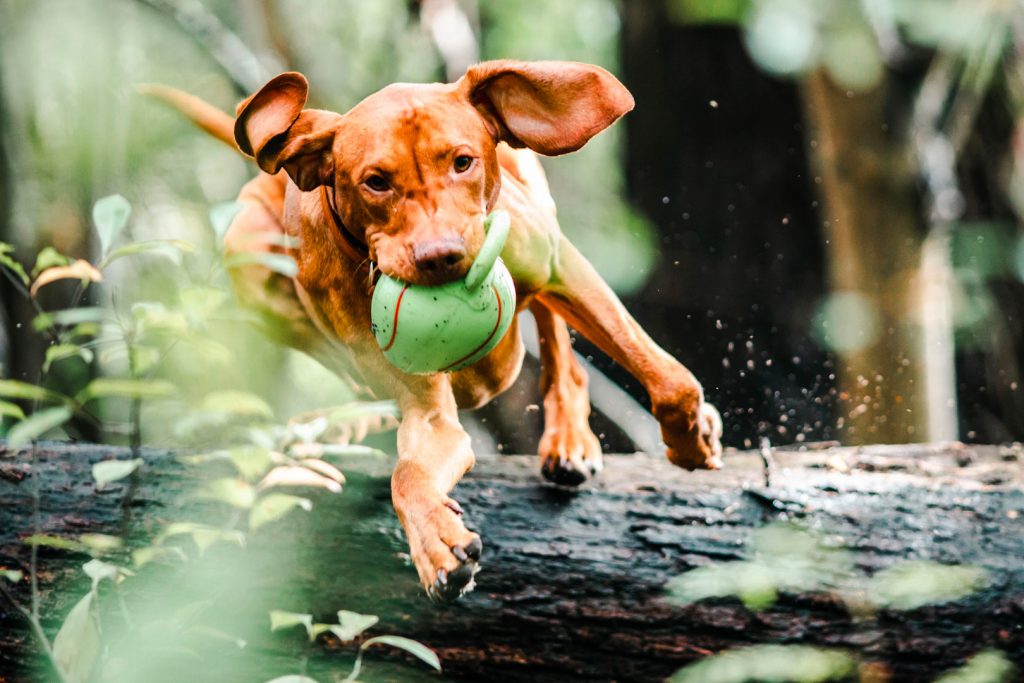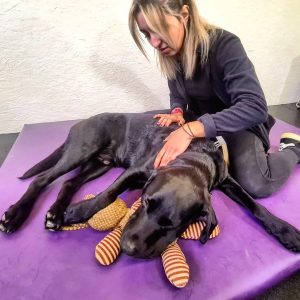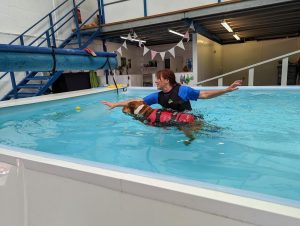The cranial cruciate ligament in dogs is the same as the anterior cruciate ligament (ACL) in humans. It is a band of tough fibrous tissue that attaches the femur (thigh bone) to the tibia (shin bone), preventing the tibia from shifting forward relative to the femur. It also helps to prevent the stifle (knee) joint from over-extending or rotating.
In the vast majority of dogs, the cranial cruciate ligament ruptures as a result of long-term degeneration, whereby the fibres within the ligament weaken over time. It is not known what the precise cause of this, but genetic factors are thought to be the most important, with certain breeds being predisposed (including Labradors, Rottweilers, Boxers, West Highland White Terriers and Newfoundlands).
Cruciate injuries can be managed surgically or non-surgically.
Conservative (non-surgical) Management
If your dog is being treated conservatively many dogs benefit from rehabilitation to protect the stifle joint and prevent further injury or stress to the joint. The cornerstones of non-surgical treatment are body weight management, physiotherapy, exercise modification and medication (anti-inflammatory painkillers).
These same techniques are also important in the short-term management of dogs who are treated surgically, although the primary surgical aim is to minimise the requirement for long-term exercise restriction and medication.
When your your dog is referred to us our physiotherapist will look closely at how your dog functions with the condition and the effect it has on the body as a whole. It is vital that the quadriceps and hamstring muscle groups are maintained as they control flexion and extension of the stifle joint. If these muscles become weak the stifle can become vulnerable and at risk of further injury.
There is a risk of “flare-ups” or exacerbation of clinical signs following trauma or inappropriate exercise when your dog has CCL disease. If this happens our therapists aims are to control the inflammation and surrounding muscle spasm while encouraging careful limb use and preventing muscle wastage.
If your dog responds positively to the conservative rehabilitation programme the aims can be adjusted to include the above with greater limb loading, further limb strengthening and increased cardiovascular fitness. Restricted walking between prescribed exercise times is likely to be advised to ensure the knee isn’t overloaded alongside the specific controlled rehabilitation exercises.
Conservative rehabilitation is not suitable for all dogs, some require surgical intervention to address cranial cruciate ligament disease, therefore, it is important your dog is reassessed to evaluate stifle stability as soon as you have concerns.
Conservative Treatment Plan
| Timescale | Aims |
| 0-4 Weeks | Reduce inflammation Reduce muscular guarding Increase strength Increase limb loading Regain normal movement patterns Maintain soft tissue length & flexibility Lifestyle management |
| 4-6 Weeks | Reduce inflammation Reduce muscular guarding Increase strength Increase limb loading Regain normal movement patterns Maintain soft tissue length & flexibility Lifestyle management Increasing proprioceptive understanding |
| 6-12 Weeks | Increasing exercise tolerance Increasing core stability |
| 12 Weeks + | Return to normal function |
Conservative Therapies
Laser Therapy
Cryotherapy
Clinical Massage
Hydrotherapy
Therapeutic Exercises
Joint Mobilisation
Lifestyle Advice
Post Surgery Rehabilitation
Following surgery it is often of benefit to quickly progress with gentle rehabilitative therapies that prevent soft tissue tightness and maintain mobility. Followed shortly afterwards by careful limb loading exercises. After 2 weeks targeted exercises can begin to further the progression of rehabilitation with ongoing review and programme development with the aim of achieving normal function.
Post Surgical Treatment Plan
| Timescale | Aims |
| 1-2 Weeks | Reduce inflammation Reduce muscular guarding Increase strength Increase limb loading Improve independence Maintain soft tissue length & flexibility |
| 2-4 Weeks | Progress strengthening Ensure correct movement patterns Maintain full range of movement |
| 4-6 Weeks | Increase strength |
| 6-12 Weeks | Increase exercise tolerance |
| 12 Weeks + | Return to previous exercise level |
Post Surgical Therapies
Laser Therapy
Cryotherapy
Clinical Massage
Hydrotherapy
Therapeutic Exercises
Joint Mobilisation
Lifestyle Advice
Please note: Rehabilitation plans should only be followed under the guidance of a qualified rehabilitation professional, who will be able to provide a tailored plan based on the individual patient’s rehabilitation needs.













